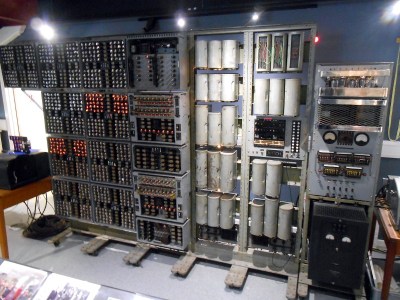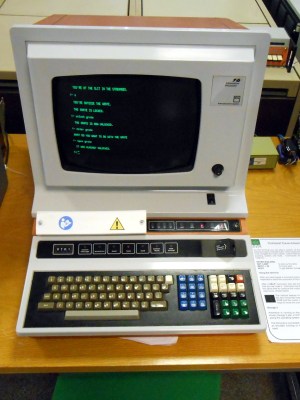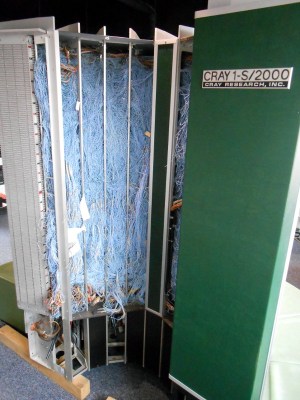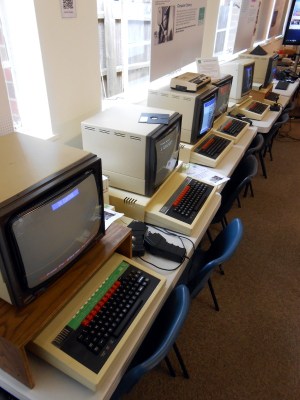Here’s a question for you all: how will you know when you are no longer young? When you fall out of love with contemporary popular music perhaps, or start to find the idea of a cruise holiday attractive? The surefire sign for many people is having to ask a teenager how a piece of technology works — this is probably not that applicable to most Hackaday readers.
How about when you’re shocked to encounter a significant part of your youth in a museum? These are supposed to be places of The Olden Days, full of rustic agricultural tools or Neolithic pottery, yet here you are in front of your teenage years presented for all to see. You have two choices: you can surrender to the inevitable and henceforth only wear beige clothing, take up golf or maybe book that old person’s cruise holiday, or you can dive in misty-eyed and reacquaint yourself with everything in front of you.
The above is probably an experience many regulars of these pages would share on a visit to Britain’s National Museum Of Computing in a corner of the famous Bletchley Park site, home of Britain’s wartime codebreaking efforts. They describe what they do on their web site as follows:
“We conserve, restore, reconstruct, and give hands-on access to historic computers and related artefacts – with a particular focus on those which were the result of pioneering British ingenuity.“
For the visitor this means that their galleries contain a huge array of computing and associated equipment, many of which are presented as working exhibits without too much of the dumbing-down that pervades so many other museums, and that the staff are extremely knowledgable about them.
The museum is housed in one of the groups of wartime codebreakers’ huts, laid out roughly in the shape of a capital H with the top of one vertical lopped off. If you are a connoisseur of British wartime sites you’ll recognise these buildings, they were built to a fairly standard design all over the country. Internally this means that the galleries are structured around the long corridors that are a staple of that era, giving in particular the earlier exhibits a feel of their time.
The main entrance is in the centre of the crossbar of the H, meaning that you arrive right in the middle and there is no fixed itinerary or progression. Instead you are left to browse the galleries at your own speed, and if you are a member of the Hackaday crew, exclaim with pleasure at each familiar exhibit.
So with your entry sticker now displayed, what next? On the left side of the H you will largely find the museum’s more historical and esoteric exhibits, on the right its more recent collections. It’s probably best to start with the older exhibits and move roughly across the complex from right to left as we describe what there is to see. We couldn’t possibly cover everything in their huge collection on these pages, however we hope to give you a flavour of what to expect.

The lower left arm of the H is devoted to Bletchley and the museum’s most famous work, the story of the wartime codebreakers, the Lorenz cipher, Tunny machine, and Colossus, the first programmable all-electronic computer. Their fully functional reconstruction of a Colossus occupies a gallery of its own. This section of the museum has already been the subject of a separate Hackaday piece, so other than to say that it would be worth the trek to Bletchley in its own right even if the rest of the collection did not accompany it we’ll leave you to read about it there.
Adjacent to the wartime galleries in the upper-left arm of the H are two galleries, one devoted to the first generation of computers in peacetime from the late 1940s and early 1950s, and the other to the mainframes that developed from them. through the late 1950s and onwards.

Here you will find the world’s oldest original digital computer still in working order, the Harwell Dekatron, also known as the WITCH, alongside one of the earliest British commercial computers, the HEC-1, and the museum’s in-progress reproduction of EDSAC, Cambridge University’s first computer. These machines are all very big devices, open racks of electronics covered with vacuum tubes.
The Harwell Dekatron is a particularly unusual machine in its use of dekatron counting tubes as memory, so when in operation the stare of all its memory locations can be seen in the location of a neon glow in each tube. It was built to perform calculations for the British nuclear industry before educating students at a college in the English Midlands (the “W” in “WITCH” stands for “Wolverhampton”) and then going to a museum in Birmingham. It came to Bletchley in 2009 after a period in museum storage, and was successfully rebooted by a team at TNMOC in 2012.
Sadly, on our visit the Dekatron was not running. The attendant told us it was an issue with the clock that they were working on — we could see the glow in each tube and he told us they could clock it manually, but for the period of our visit at least it was a static exhibit. Keeping a computer nearly 70 years old in daily operation is understandably a Herculean task, we were simply unlucky with our timing.

Adjacent to the early machines is the museum’s gallery of mainframe computers. In here you’ll find among others British Elliott machines from the 1960s, an IBM 1130 again from the 1960s, and a range of ICL machines from the 1980s and 1990s including the museum’s largest exhibit, an ICL 2966. Again the attendants here really know their stuff, and the machines will usually be up and running. On our visit for example the Elliott 803B was running a simple musical synthesiser, and the ICL mainframe was running an interactive text adventure game.
Back along the crossbar of the H, and you pass galleries containing analogue computers and punched-card handling equipment. The analogue gallery features a Pace TR-48 analogue computer formerly used in the aeronautical industry, the museum have it wired in a simulation of a car suspension system. Meanwhile the punched-card gallery has among other exhibits the Powers-Samas machines originally used to calculate mileages and payroll for Blackpool Corporation bus drivers.
On the right and side of the H crossbar, past the museum entrance, are the galleries containing more familiar and modern computers. Past an interactive gallery celebrating the historical contribution of women in computing with its large portrait of Ada, Countess Lovelace, and there is a gallery exploring the world of software with a split into home, languages, business, and robotics. In the last section was something instantly recognisable on a personal basis as someone at school in the early 1980s, a BBC Buggy educational robot configured as a line follower. Today it is driven by an Arduino, but it brought back memories of learning about stepper motors in BBC BASIC.
From here after a section looking at the world of air traffic control you enter much more familiar territory as the museum takes you through the development of personal computing. On show are 8- and 16-bit computers from the 1970s, 80s, and 90s, from the simplest of home computers to PCs. A chance for a moment to waste some time playing a level or two of Lemmings on an Acorn Archimedes, or exclaim at the entire range of Sinclair microcomputers in one display.

A further room houses a wall of games consoles and a few arcade machines which seemed to be very popular with a lot of younger visitors, and rather incongruously alongside them, a Cray-1 supercomputer and an INMOS Transputer development system. The Cray is famous enough to be instantly recognisable with its padded seat covering the cooling system, though sadly we were not allowed to sit on it. It did provide a fascinating chance to look at the extremely complex wiring between the card frames that make up its tower, reportedly a critical feature of its legendary speed for the era as it was constructed to deliver very careful timing of transmission paths between cards. Meanwhile the Transputer is an odd relic of what might have been from a failed British semiconductor company, a massively parallel processing architecture on a single chip with an on-board serial interconnect. In the late 1980s this was seen as the Next Big Thing, and quite a few of us Brits who studied computer science or electronic engineering around that time will have worked on Transputer projects at university. Many of the Transputer ideas can be found in modern architectures, and something quite close to the original is still in production and development with a spin-off company from the original INMOS team.
Round the corner into the lower-right arm of the H, and we enter Acorn territory. If you are not British you might not be familiar with Acorn, but if you own a device featuring an ARM processor you have a piece of its legacy. One of the leading players in the microcomputer boom of the early 1980s, their computers were ubiquitous in British schools and it was for their Archimedes desktop computer that they developed the first ARM. The “A” in “ARM” originally stood for “Acorn”.

So the museum’s Acorn gallery has almost all the company’s products in one place, including rarities such as the Archimedes laptop and unusual BBC Micro co-processor units alongside the more familiar Acorn Electrons, BBC Micros, Archimedes systems, and a contemporary Raspberry Pi running the latest version of the Archimedes-derived OS, RISC OS. For a secondary school student of the 1980s this was an opportunity to wallow in the past, dredge up those lost BBC BASIC skills, and desperately try to remember the quirks of the RISC OS desktop. During our visit this room also had an Occulus VR demonstration, and an Aldebaran/Softbank Pepper humanoid robot showing off its capabilities.
The final gallery before you reach the museum exit, cafe, and gift shop is an Internet gallery. You might expect from its name that this would be a tame and predictable display of web browsers, but fortunately this is TNMOC. Instead you get a comprehensive run-down of the history of packet switching and the underlying technologies of the Internet, with a significant input from the National Physical Laboratory.
This breakneck-speed run through the TNMOC galleries has not by any means covered the entirety of the collection. In particular we have not mentioned the supplemental exhibitions housed in the corridors, on the history of the slide rule, the electronic calculator, self-built computers, Sinclair Research, early ARM-based boards, or even a display of marketing ephemera from computer companies. There is easily enough in this collection for the average Hackaday reader to spend an entire day browsing, and then still find things they missed the first time if they make a second visit. It’s certainly a journey the Hackaday crew on whose visit this review is based will make again.
The National Museum Of Computing can be found in Block H of the Bletchley Park site, which in turn is opposite Bletchley railway station in modern-day Milton Keynes. It is a separate attraction from the codebreaking museum in the main Bletchley Park house operated by the Bletchley Park Trust, and it is run by a charitable trust that relies on donations and admission fees for its continued existence.
The Bletchley Park site is now a conservation area protected from development, and as well as the two museums contains an innovation centre, the RSGB National Radio Centre, and a memorial to the work of Polish codebreakers on which the Enigma decryption was built. A significant portion of the wartime buildings are still undergoing restoration or are yet to be restored. We would like to recommend it, and the National Museum Of Computing in particular, as somewhere you should visit.
If you have an interest in historic computer hardware, we’d also like to suggest you take a look at the Computer Conservation Society, who have been responsible for the restoration of many of the machines mentioned above.















They should make it an international museum of computing. Not only is the whole development a global effort, but it’s interesting to hear what various nations contributed.
When you start one, I’ve got a Convex supercomputer to donate!
It’d be really interesting to hear about the specs on your computer.
Convex Exemplar SPP-1600, two cabinet’s worth. Basically looks like 2/3 of this http://archive.computerhistory.org/resources/still-image/Convex/convex_exemplar.102627726.lg.jpg IIRC it’s 32 CPUs, 4GB memory. Has a little workstation (also HP-UX) that acts as the management gateway for it. Had it up and running for a couple days, several years ago — it pulls a lot of power.
The first 10 years of digital TV in the UK saw the production of dozens makes and models of set top boxes almost all of which contained a CPU derived from the Transputer.
The basic design takes up so little silicon that in applications where the CPU spends most of it’s time setting up and supervising dedicated hardware blocks an SoC becomes competitive with a Transputer CPU before anything else. Well, that my interpretation.
Looks like a lot of fun to debug this Cray…
Fortunately that’s just the backplane and there’s not much reason to mess around with it. The real fun is in the cards which slot in from the outer perimeter.
AFAIK there is no USA-based National Computer Museum, which strikes me as a real pity.
Computer History Museum
1401 N. Shoreline Blvd
Mountain View, CA 94043
http://www.computerhistory.org/
also the (much smaller) American Computer & Robotics Museum, in Bozeman MT. http://www.compustory.com/
Fabrice Lété has prepared an annotated world map of all known computer history museums: https://goo.gl/NOi6xy
Corrections and additions are welcome at https://plus.google.com/u/0/+FabriceL%C3%A9t%C3%A9/posts/6nj4EoVtER2
The Living Computer Museum
2245 1st Ave S
Seattle, WA 98134
http://www.livingcomputermuseum.org/
Never mind seeing stuff from your youth that you used – what about when you see things you helped develop!
Wrong Hackaday writer for that I’m afraid. [Bil Herd] will no doubt be along shortly :)
Yeah, I know Bil will have had the same sort of experiences, though in the US. I probably ought to raid the loft and donate some stuff…
Well, of course if you have interesting stuff, Hackaday are always looking for things to write about…
I am already old. I remember when computer had text only display in 2 colors, saving and loading program was done via tape that took several bytes per second, and when adding another 2k RAM was a few hundred dollars job. I was also one of the top kid in elementary school having done well in BASIC and mastered LOGO and helped teach older kids LOGO. (yes older kids, I was 7 at the time when most people have only seen computer in sci-fi shows)
If anyone knows where my first girlfriend, a PET 2001 with tiny keyboard and built in tape drive is hiding, I’d like to pick one up. It’d go nice with my SuperPET 9000
Only ever seen one PET like that, at secondary school next to the RML380Z. It’s probably gone by now :)
TNMOC have a 380Z – I noticed it because it’s what I did my O-Level on (that dates me…)
You had color!
Think he means green and black.
Yes, green and black.
The transputer became the ST20, and is probably still kicking around in hundreds of thousands of dusty Sky DVB-S boxes!
“a capital H with the top of one vertical lopped off” So, a lower-case ‘h’?
You are not wrong :)
I think I was thinking of the standard layout for these blocks, which is a capital H. THis one is adjacent to the perimeter of the site, so had to lose one arm for it to fit.
I’m glad to see this review to complement your other review http://hackaday.com/2016/08/23/colossus-face-to-face-with-the-first-electronic-computer/
I’d like to emphasise your points about the attendants by reiterating my comment from that thread: “More importantly, interestingly and almost uniquely, the “attendants” actually know a *lot* about the exhibits. For example, when I was there I started chatting about the first computer I used (Elliott 803, 8Kwords, 39bit words, 576us cycle time) – and the person I was talking to whipped out the original circuit diagrams (>A0 size “blueprints”) and we started discussing them.”
TNMoC is indeed well worth a visit. (And the next time I visit I’ll try to find a bit of time to see the other museum on the site :) )
I can only agree. It would be worth the admission charge just to stand in empty rooms and pick their brains :)
Nicely put – and it is accurate too!
Jenny List says: “I can only agree. It would be worth the admission charge just to stand in empty rooms and pick their brains :)”
Mentioned in passing by vital to any visitor is that this is an entirely separate entity to the Bletchley Park Trust Museum and thus can be visited without paying the entrance there. If by car, once past the main entrance barrier just keep driving on around to your left an all the way to the back of the site while still outside the Park museum.
This separation by the way has been a thing of consternation to the computer museum as a sizeable grant given to the Bletchley Trust was done so while the computer museums assets were quoted on their prospectus, yet not a penny of that grant was passed on to the computer museum. In fact quite soon after the first action of the trust was to fence off their part of the site from the computer museum forcing visitors to always return to the main entrance to go between museums, quite a hike on a hot day.
Very true. Still, it works both ways. I would have devoted a further article to reviewing the Bletchley Park museum, but someone had put a fence in the way.
If you visit TNMOC (which I highly recommend), don’t just turn up, but pre-book a tour. The guide of the group I was in described a lot of detail about the exhibits and the working of the museum.
If you have been thinking of going to TNMoC (and if not, why not?), but haven’t got A Round Tuit, then consider…
Why not go to the large and good Dunstable Downs hamfest in the morning of 17th May, and then TNMoC (or Bletchley Park if you insist) in the afternoon? I will.
FFI: http://www.ddrcbootsale.org/